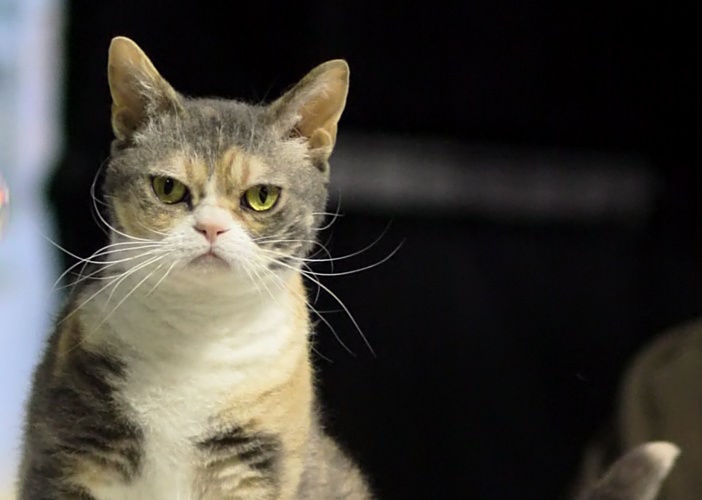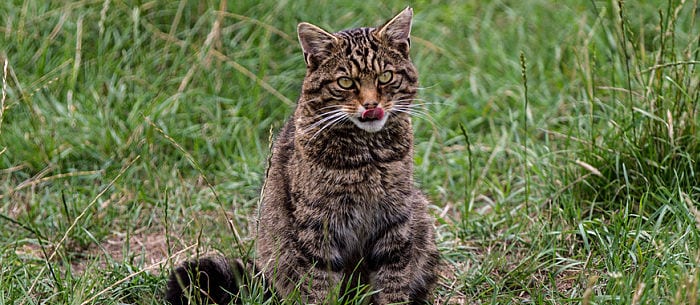1. Kodkod
 The International Union for Conservation of Nature (IUCN) lists the Kodkod as a vulnerable species due to habitat loss and fragmentation. These small cats, weighing in at three to seven pounds, live in a limited range in the dense forests of Chile and Argentina. Also the smallest feline in the Americas, they have black-spotted coats in grays and browns and short, thick tails.
The International Union for Conservation of Nature (IUCN) lists the Kodkod as a vulnerable species due to habitat loss and fragmentation. These small cats, weighing in at three to seven pounds, live in a limited range in the dense forests of Chile and Argentina. Also the smallest feline in the Americas, they have black-spotted coats in grays and browns and short, thick tails.
2. Pallas’s Cat
 Fluffy and stocky with an expressive face, these rare felines live in the Central Asian region and can be found in Mongolia, Kazakhstan, Pakistan, Afghanistan, China, Mongolia and Russia, among other countries. According to the Smithsonian’s National Zoo & Conservation Biology Institute, their long, thick coat protects them from the harsh climate they call home and they have low-set ears, which helps them to sneakily peer over rocks. Pallas’s cats have a similar size to domestic breeds and were once thought, incorrectly, to be predecessors of Persian cats.
Fluffy and stocky with an expressive face, these rare felines live in the Central Asian region and can be found in Mongolia, Kazakhstan, Pakistan, Afghanistan, China, Mongolia and Russia, among other countries. According to the Smithsonian’s National Zoo & Conservation Biology Institute, their long, thick coat protects them from the harsh climate they call home and they have low-set ears, which helps them to sneakily peer over rocks. Pallas’s cats have a similar size to domestic breeds and were once thought, incorrectly, to be predecessors of Persian cats.
3. Sphynx
 When it comes to unusual, the Sphynx cat tops the list. The breed originated in Canada in the 1960s from a genetic mutation, says The Cat Fanciers’ Association. While often called hairless, the Sphynx actually has a very fine down-like coat. The large ears and eyes add to the distinct appearance of the cat. This high-energy feline typically costs between $2,000 and $3,000, according to FVEAP.
When it comes to unusual, the Sphynx cat tops the list. The breed originated in Canada in the 1960s from a genetic mutation, says The Cat Fanciers’ Association. While often called hairless, the Sphynx actually has a very fine down-like coat. The large ears and eyes add to the distinct appearance of the cat. This high-energy feline typically costs between $2,000 and $3,000, according to FVEAP.
4. Fishing Cat
 The fishing cat lives primarily across South and Southeast Asia, according to the Smithsonian’s National Zoo & Conservation Biology Institute. The largest of the “small cats,” they weigh anywhere from 11 to 31 pounds. This aptly named cat primarily hunts fish — they can even swim underwater! — but will also dine on small birds or amphibians. The Smithsonian currently lists fishing cats under “vulnerable” conservation status due to habitat loss by human development in wetlands and poaching.
The fishing cat lives primarily across South and Southeast Asia, according to the Smithsonian’s National Zoo & Conservation Biology Institute. The largest of the “small cats,” they weigh anywhere from 11 to 31 pounds. This aptly named cat primarily hunts fish — they can even swim underwater! — but will also dine on small birds or amphibians. The Smithsonian currently lists fishing cats under “vulnerable” conservation status due to habitat loss by human development in wetlands and poaching.
5. Iberian Lynx
 Only 100 Iberian lynxes were alive in 2002 and these rare cats remain critically endangered. Numbers have increased to over 300 due to conservation efforts, with 53 cubs born in 2015 according to the World Wildlife Fund (WWF). The Iberian lynx populates the Mediterranean forests of the Iberian Peninsula. The medium-sized cat weighs up to 30 pounds and has a distinct appearance with ear tufts and a beard.
Only 100 Iberian lynxes were alive in 2002 and these rare cats remain critically endangered. Numbers have increased to over 300 due to conservation efforts, with 53 cubs born in 2015 according to the World Wildlife Fund (WWF). The Iberian lynx populates the Mediterranean forests of the Iberian Peninsula. The medium-sized cat weighs up to 30 pounds and has a distinct appearance with ear tufts and a beard.
6. Scottish Wildcat
 With fewer than 100 left in the wild, these cats are one of the rarest cat breeds in the world. Scottish wildcats resemble a large tabby cat. They have a muscular build, a ringed tail and a thick coat. While stories of them hunting larger animals exist, they primarily eat small prey animals, like rodents and rabbits, per Save the Scottish Wildcat.
With fewer than 100 left in the wild, these cats are one of the rarest cat breeds in the world. Scottish wildcats resemble a large tabby cat. They have a muscular build, a ringed tail and a thick coat. While stories of them hunting larger animals exist, they primarily eat small prey animals, like rodents and rabbits, per Save the Scottish Wildcat.
7. Korat
 The Korat cat dates back hundreds of years in Thailand. A fairly small, domesticated cat weighing less than 10 pounds, the breed has a unique heart-shaped head and silvery-blue fur, according to the International Cat Association. Korat cats were traditionally given as gifts, often to brides. The genetic pool for Korats remains small, making them one of the world’s rarer cat breeds. Costs for Korat kittens and cats range from several hundred to thousands of dollars.
The Korat cat dates back hundreds of years in Thailand. A fairly small, domesticated cat weighing less than 10 pounds, the breed has a unique heart-shaped head and silvery-blue fur, according to the International Cat Association. Korat cats were traditionally given as gifts, often to brides. The genetic pool for Korats remains small, making them one of the world’s rarer cat breeds. Costs for Korat kittens and cats range from several hundred to thousands of dollars.
8. Black-footed Cat
 With their big eyes and small size, these cats could pass for a kitten. Weighing in at only two to four pounds, the ISEC says the black-footed cat is the smallest of its kind on the African continent. Don’t let the cute face and tiny size fool you. These cats can and will defend themselves against jackals and hunt large prey.
With their big eyes and small size, these cats could pass for a kitten. Weighing in at only two to four pounds, the ISEC says the black-footed cat is the smallest of its kind on the African continent. Don’t let the cute face and tiny size fool you. These cats can and will defend themselves against jackals and hunt large prey.
9. Sand Cat
 Another cat that ranks high on the cuteness scale, the sand cat lives in the Saharan and Middle Eastern deserts. According to ISEC, sand cats weigh three to eight pounds and have thick fur, including on the bottoms of their paws to protect them from the heat. Competition for resources, habitat loss and illegal capturing and selling makes the already rare cat even lower in numbers.
Another cat that ranks high on the cuteness scale, the sand cat lives in the Saharan and Middle Eastern deserts. According to ISEC, sand cats weigh three to eight pounds and have thick fur, including on the bottoms of their paws to protect them from the heat. Competition for resources, habitat loss and illegal capturing and selling makes the already rare cat even lower in numbers.
10. American Wirehair
The American Wirehair has a wool-like, springy coat. The medium-sized cat makes an affectionate housecat. American Wirehairs were developed in the late ’60s in New York, according to the CFA. With few registered wirehairs, the cat tops the list of rare cat breeds, and its high cost reflects that.
Like what you're reading?Join Care for free
Already Registered
The email you entered is already registered. Would you like to log in?
Log In
by
Kit Arbuckle
Kit Arbuckle writes for numerous websites on topics that include parenting and education choices for children.













